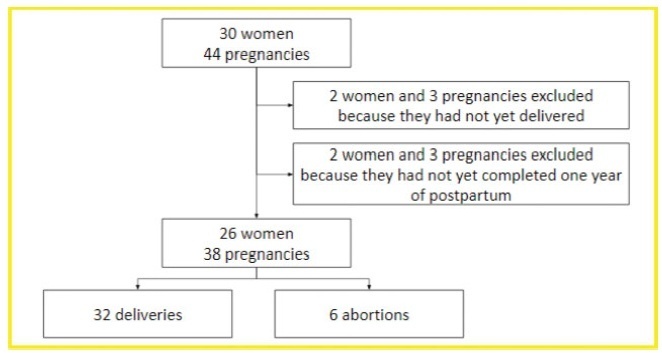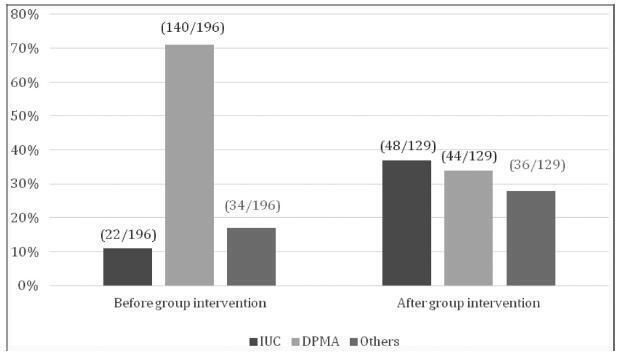-
Original Article
Disease Progression and Obstetric Outcomes of Women with Multiple Sclerosis at a Reference Center in Northeastern Brazil
Revista Brasileira de Ginecologia e Obstetrícia. 2021;43(3):165-171
05-24-2021
Summary
Original ArticleDisease Progression and Obstetric Outcomes of Women with Multiple Sclerosis at a Reference Center in Northeastern Brazil
Revista Brasileira de Ginecologia e Obstetrícia. 2021;43(3):165-171
05-24-2021Views188See moreAbstract
Objective
To describe the obstetric outcomes of patients withmultiple sclerosis (MS) and the impact of pregnancy and the postpartum period on the progression of the disease.
Methods
A case series study performed between December 2019 and February 2020, reporting pregnancies occurred between 1996 and 2019. The subjects included were women with MS undergoing follow-up at an MS referral center in Northeastern Brazil, and who had at least one pregnancy after the onset of MS symptoms, or who had their first relapse in the first year after delivery.
Results
In total, 26 women and 38 pregnancies were analyzed - 32 of them resulted in delivery, and the remaining 6, in miscarriages. There was a significant increase in the prevalence of relapse during the postpartum period when compared with the gestational period. In 16 (42.1%) of the pregnancies, there was exposure to diseasemodifying therapies (DMTs) - 14 (36.8%), to interferon β, and 2 (5.3%), to fingolimod. Higher rates of abortion, prematurity and low birth weight were reported in the group was exposed to DMT when compared with the one who was not.
Conclusion
In the sample of the present study, there was a significant increase in the rate of MS relapse during the postpartum period when compared with the gestational period. Additionally, it seems that exposure to DMTs during pregnancy may affect the obstetric outcomes of the patients.

-
Original Article
Gestational Diabetes Mellitus and Obesity are Related to Persistent Hyperglycemia in the Postpartum Period
Revista Brasileira de Ginecologia e Obstetrícia. 2021;43(2):107-112
01-19-2021
Summary
Original ArticleGestational Diabetes Mellitus and Obesity are Related to Persistent Hyperglycemia in the Postpartum Period
Revista Brasileira de Ginecologia e Obstetrícia. 2021;43(2):107-112
01-19-2021Views228See moreAbstract
Objective
To evaluate the obstetric and sociodemographic characteristics of gestational diabetic women who maintained hyperglycemia in the postpartum period (6-12 weeks postpartum).
Methods
This is a longitudinal cohort study with women who have had gestational diabetes and/or macrosomic children between March 1st, 2016 and March 1st, 2017. Between 6 and 12 weeks after birth, women who had gestational diabetes collected fasting glycemia, glucose tolerance test, and glycated hemoglobin results. The data were collected from medical records and during an interview in the first postpartum consultation. A statistical analysis was performed using frequency, percentage, Chi- Squared test, Fisher exact test, Mann-Whitney test, and multivariate Poisson regression. The significance level adopted for the statistical tests was 5%.
Results
One hundred and twenty-two women were included. Most of the women were younger than 35 years old (70.5%), white, multiparous, and with no history of gestational diabetes. Thirteen percent of the participants developed persistent hyperglycemia. A univariate analysis showed that maternal age above 35 years, being overweight, having grade 1 obesity and weight gain under 5 kg was related to the persistence of hyperglycemia in the postpartum period.
Conclusion
Maternal age above 35 years, obesity and overweight, and the diagnosis of gestational diabetes in the first trimester of pregnancy are associated with hyperglycemia during the postpartum period.
-
Original Article
Empowering Adolescent Mothers in the Choice of Contraceptive Methods at the Postpartum Period: Avoiding a Subsequent Pregnancy
Revista Brasileira de Ginecologia e Obstetrícia. 2019;41(10):607-612
11-07-2019
Summary
Original ArticleEmpowering Adolescent Mothers in the Choice of Contraceptive Methods at the Postpartum Period: Avoiding a Subsequent Pregnancy
Revista Brasileira de Ginecologia e Obstetrícia. 2019;41(10):607-612
11-07-2019Views147Abstract
Objective
Almost 80% of adolescent pregnancies are unplanned, and between 28 and 63% of adolescent mothers had a repeated pregnancy within 18 months. Among girls with repeated pregnancies, two-thirds reported that the pregnancy was unplanned. We aim to assess contraceptive use by adolescent mothers with increasing choice for long-acting reversible contraception (LARC) methods in postpartum consultation after a semistructured group intervention involving adolescent mothers.
Methods
Retrospective observational study conducted at the Universidade Estadual de Campinas, Campinas, state of São Paulo, Brazil, involving new antenatal and postpartum education groups for adolescents. At postpartum consultations, the adolescents chose their contraceptive. The datawas compared with previous series followed in a period before the implementation of the education group - a historical control group.
Results
We included 129 adolescent after childbirth from January 1st, 2015 through July 31st, 2017. Out of this total, 63% had ever used contraceptive methods before pregnancy, and the most frequent method was combined oral contraceptives (33%) followed by condoms (21%). At the first postpartum consultation, the most common contraceptive chosen was intrauterine contraception (IUC) (37.2%) and depot-medroxyprogesterone acetate (DMPA) (34.1%).When comparing the rates before and after the education interventions, there was a 3-fold increase in the use of IUCs.
Conclusion
Antenatal and postpartum education have shown a significant increase in the choice for LARC methods among adolescent mothers, with very high acceptability after a period using the method. The educational groups performed during the antenatal care and beyond the gestational period are easy to be applied worldwide with low dependence on funding.
Key-words Adolescentantenatal educationContraceptionlong-acting reversible contraceptionPostpartum periodSee more
-
Original Article
Lessons from the Field Beyond the Numbers: Narratives of Professionals on Women who Experienced Severe Maternal Morbidity
Revista Brasileira de Ginecologia e Obstetrícia. 2019;41(6):379-386
07-22-2019
Summary
Original ArticleLessons from the Field Beyond the Numbers: Narratives of Professionals on Women who Experienced Severe Maternal Morbidity
Revista Brasileira de Ginecologia e Obstetrícia. 2019;41(6):379-386
07-22-2019Views216See moreAbstract
Objective
Several factors might affect the health and the quality of life of women who had a severe maternal morbidity (SMM) or a maternal near-miss (MNM) episode. The objective of the present study was to explore the perspectives of the professionals on the repercussions of SMM or of MNM after interviewing women who survived such episodes.
Method
Selected cases that captured the attention of professionals were reported. The professionals built individually 10 narratives, which were analyzed with the technique of content analysis.
Results
According to the perspectives of the professionals, women surviving a severe maternal condition and their families experienced clinical and psychosocial consequences. Some cases portrayed the intense psychological distress in mourning for the loss of the fetus or of their reproductive capacity and changes in family dynamics generating emotional overload, depression, and gender violence.
Conclusion
The analysis of narratives may offer an idea on the complexity of the perception of care by professionals and on the need for an interdisciplinary follow-up of women surviving an SMM or an MNM episode.
-
Original Articles
Maternal Weight Variation in Different Intrauterine Environments: An Important Role of Hypertension
Revista Brasileira de Ginecologia e Obstetrícia. 2019;41(4):220-229
06-19-2019
Summary
Original ArticlesMaternal Weight Variation in Different Intrauterine Environments: An Important Role of Hypertension
Revista Brasileira de Ginecologia e Obstetrícia. 2019;41(4):220-229
06-19-2019Views187See moreAbstract
Objective
Different intrauterine environments may influence the maternal prepregnancy body weight (BW) variation up to 6 months postpartum. The objective of the present study was to verify the association of sociodemographic, obstetric, nutritional, and behavioral factors with weight variation in women divided into four groups: hypertensive (HM), diabetic (DM), smokers (SM), and control mothers (CM).
Methods
It was a convenience sample of 124 postpartum women recruited from 3 public hospitals in the city of Porto Alegre, state of Rio Grande do Sul, Brazil, between 2011 and 2016.Multiple linear regressions and generalized estimating equations (GEE) were conducted to identify the factors associated with maternal weight variation. For all GEE, the maternal weight measurements were adjusted for maternal height, parity, educational level, and the type of delivery, and 3 weight measurements (prepregnancy, preceding delivery, and 15 days postpartum) were fixed.
Results
A hierarchical model closely associated the maternal diagnosis of hypertension and a prepregnancy body mass index (BMI) classified as overweight with maternal weight gain measured up to the 6th month postpartum (the difference between the maternal weight at 6months postpartum and the prepregnancy weight). These results showed that the BW of the HM group and of overweight women increased ~ 5.2 kg 6 months postpartum, compared with the other groups. Additionally, women classified as overweight had a greater BW variation of 3.150 kg.
Conclusion
This evidence supports the need for specific nutritional guidelines for gestational hypertensive disorders, as well as great public attention for overweight women in the fertile age.
-
Case Report
Embolization of Ruptured Renal Angiomyolipoma in Puerpera
Revista Brasileira de Ginecologia e Obstetrícia. 2019;41(3):199-202
03-13-2019
Summary
Case ReportEmbolization of Ruptured Renal Angiomyolipoma in Puerpera
Revista Brasileira de Ginecologia e Obstetrícia. 2019;41(3):199-202
03-13-2019Views119See moreAbstract
Angiomyolipomas (AMLs) are rare benign tumors derived from mesenchymal tissue and composed of varying degrees of adipose tissue, muscle and blood vessels. Renal AMLs (RAMLs) are the result of a sporadic event, and, in most of cases, the diagnosis is usually incidental, but hemorrhage and shock may be present. During pregnancy, the size of AMLs may increase and they may rupture, probably due to the high expression of hormone receptors, and the increase in maternal circulation and abdominal pressure. The authors present a case of a woman with ruptured RAML submitted to urgent endovascular treatment four days after giving birth by cesarean section.
-
Review Article
Breastfeeding and the Benefits of Lactation for Women’s Health
Revista Brasileira de Ginecologia e Obstetrícia. 2018;40(6):354-359
06-01-2018
Summary
Review ArticleBreastfeeding and the Benefits of Lactation for Women’s Health
Revista Brasileira de Ginecologia e Obstetrícia. 2018;40(6):354-359
06-01-2018Views411See moreAbstract
The offer of the maternal breast to the baby is an unquestionable right of mothers and their children, and all efforts should bemade to promote, follow and maintain exclusive breastfeeding for up to 6months and supplement it until the child completes 2 years of age. Many publications are available in the literature about the qualities of breast milk, its benefits and health repercussions, stimulating the practice of breastfeeding and supporting campaigns for its implementation. However, although it is widely known that breastfeeding is an important step in the reproductive process of women and its practice offers benefits to both mother and child, most of the available information highlights the benefits of breast milk for children, while mention of the effects of breastfeeding on the health of the mother is usually neglected. Thus, the objective of the present study is to highlight the multiple benefits of breastfeeding for the physical and emotional health of the nursing mother. The authors consulted articles published in the databases PubMed, Virtual Health Library andWeb of Science using the keywords breastfeeding, breast milk, lactation and maternal health.


